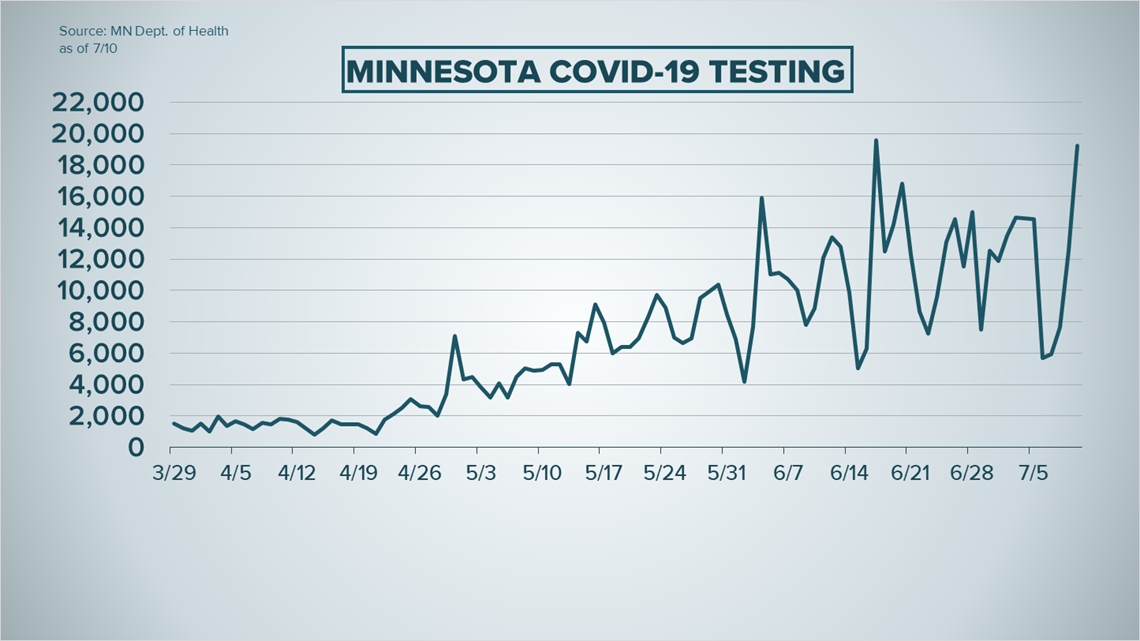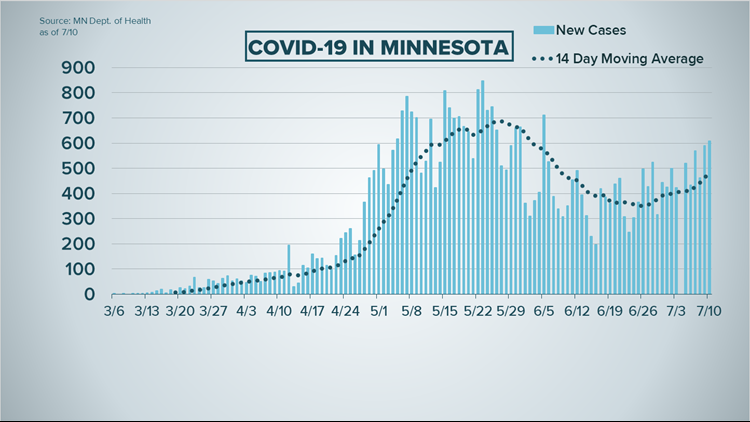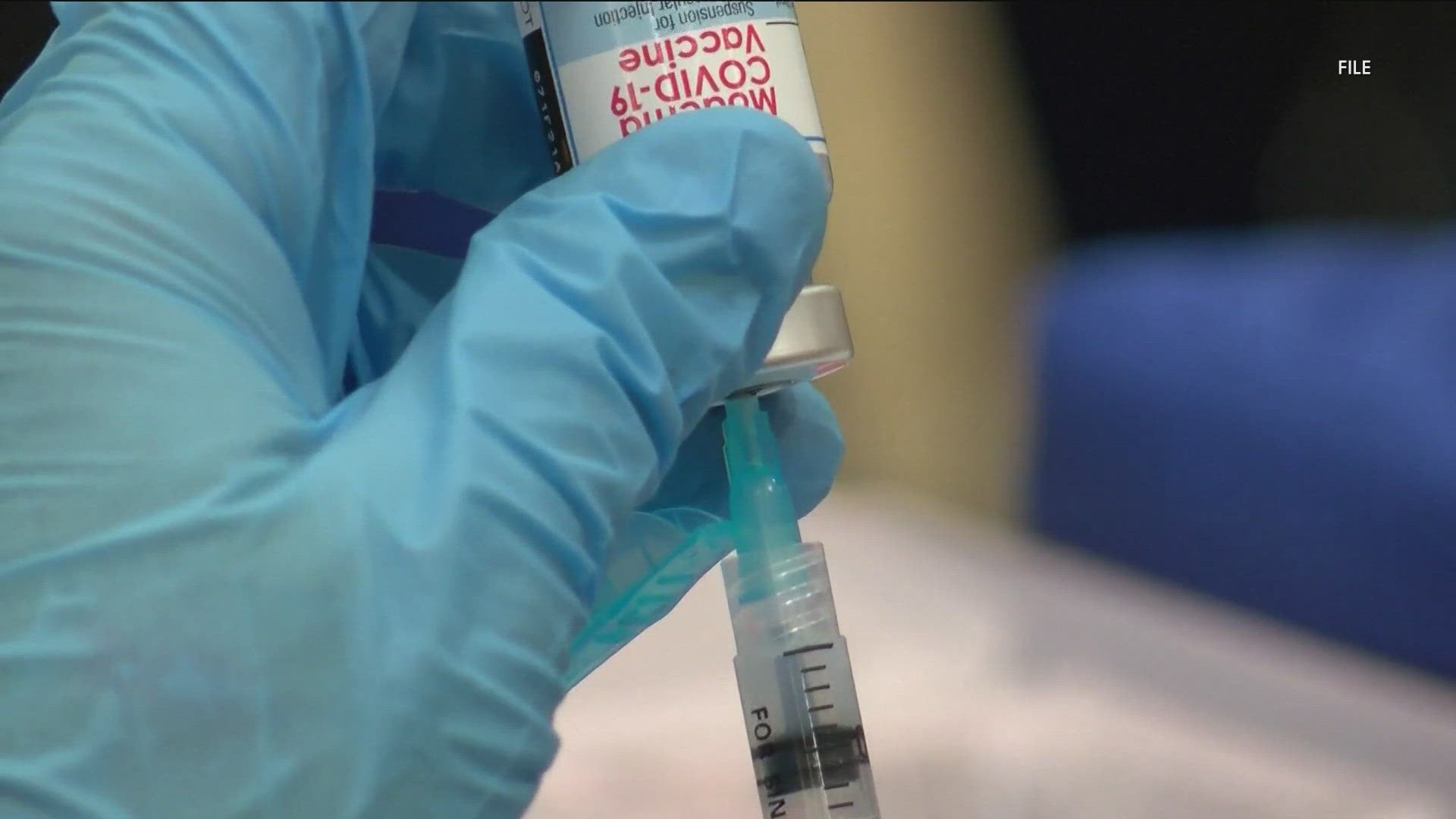Saturday, July 11
- Minnesota records increase of 806 confirmed COVID-19 cases
- Wisconsin sets daily case record
2 p.m.
Of the nearly 682,183 tests conducted thus far, the Wisconsin Department of Health Services announced Saturday that its COVID-19 case count has risen by 926 to a total of 35,679 - the state's highest daily change in positive cases on record.
Roughly 821 (2.3%) of those afflicted with the virus have died, with an increase of seven deaths since Friday.
3,797 individuals (10.6%) have required some form of hospitalization.
Younger Wisconsinites represent the largest share of COVID-19 cases, with 20-49 year olds collectively making up nearly 58% of all cases (with 20-29 year olds making up the overall largest share of cases at 25%).
Meanwhile, deaths skew toward the other end of the age spectrum, with those 60 years of age and older accounting for a combined 88% of total deaths (with 70-79 year olds accounting for the largest share at 26%).
Cases are largely centered around the state's larger population centers with Milwaukee County at 13,661 cases. This is followed by Brown County at 3,197 cases, and Dane County at 2,884 cases.
More granular information is available on the Wisconsin Department of Health Services website.
11 a.m.
The Minnesota Department of Health (MDH) reported 806 newly confirmed COVID-19 cases Saturday, bringing the total number of Minnesotans who have tested positive for the virus since the pandemic began to 41,571.
MDH says another four Minnesotans have died of complications from the virus during the past day, bringing the total number of fatalities in the state to 1,499.
Minnesota hospitals are currently treating 241 patients for the coronavirus, with 121 of them dealing with symptoms serious enough to require care in the ICU.
Of those who have tested positive, people between the ages of 20-29 account for the most cases with 9,474 cases and two deaths, and those ages 30-39 follow with 7,903 cases and 11 deaths. Those between 80 and 89 years old account for the highest number of fatalities in one age group, at 512, out of 1,639 confirmed cases.
Hennepin County has the most cases in the state at 13,328, with 790 deaths, followed by Ramsey County with 5,169 cases and 232 deaths. Dakota County reports 2,655 cases and 96 deaths.
Friday, July 10
2 p.m.
Minnesota Department of Health Commissioner (MDH) Jan Malcolm said the average age of coronavirus cases in the state continues to decline, falling to an average of 38.1 years as of Thursday.
The state reported 609 new cases on 19,213 lab tests on Friday, the second-highest testing level so far. Malcolm said the seven-day rolling average positivity rate is now 4.5%, up from 3.8% one week ago. Over the past week, testing is up 12.5%, with cases up 8.3% in that same time.
Malcolm said the federal government is moving to a new process for distributing remdesivir, a drug under trial as a COVID-19 treatment. The federal government is ending its free distribution program and hospitals will now be required to purchase the drug.
Also Friday, MDH announced new guidance for visiting long-term care facilities. Such facilities can now designate "essential caregivers" to help provide care to residents, including family, friends or volunteers.
MDH officials said the intention is to balance COVID-19 prevention with the well-being of residents to limit the harms of social isolation.
Malcolm cautioned the new guidance does not open up long-term care facilities to all visitors. For those not designated as an essential caregiver, outdoor or window visitation policies still apply.
MDH Infectious Disease Division Director Kris Ehresmann warned about testing delays in Minnesota, saying that some national labs are taking as long as a week and a half to get results back to people, while labs in Minnesota may be seeing a delay of a couple of days.
Ehresmann said the demands on the system nationally, including the supply chain, have contributed to those delays.
"It’s really important that if it does take quite a while to get your results that you are not circulating in society," Ehresmann said.
Malcolm said that MDH is still working on guidance for Minnesota schools for the fall, in partnership with the Minnesota Department of Education. MDH has already asked schools to be prepared for three scenarios: in-person classes, distance learning, or a hybrid.
"It’s highly possible that districts may find themselves using a combination of approaches during the year," she said.
Unrelated to COVID-19, during Friday's briefing with reporters, MDH Infectious Disease Director Kris Ehresmann cautioned Minnesotans about the potential risk of exposure to Naegleria, the so-called "brain-eating amoeba," in fresh water lakes due to the warmer weather in the state in recent days. Ehresmann cautioned fresh water swimmers to assume the amoeba is present and to keep their head out of the water or use nose clips, and avoid stirring up sediments in the water.
11 a.m.
New COVID-19 cases continue to climb in Minnesota, with 609 reported on Friday, the highest in over a month.
The Minnesota Department of Health (MDH) reported the 609 positive tests out of a volume of 19,204 tests - the second-highest testing day yet.
Friday's case count is the highest it's been since June 5 with 712 cases. The highest number on any day during the pandemic so far was 847 cases reported on May 23.
Health officials have been watching the case numbers to see the effect of the long holiday weekend over July 4.
MDH also reported five new deaths on Friday, bringing the total number of COVID-related deaths in Minnesota to 1,495. Of those, 1,166 happened in assisted living or long-term care.
Two hundred twenty-seven people are currently hospitalized in Minnesota, with 124 of them in the ICU. MDH has pointed to the downward or steady trend in hospitalizations as a good sign.


On Wednesday, Gov. Tim Walz said he is considering some kind of statewide mask mandate.
"Minnesota's on a good path," he said at that time, but acknowledged that increasing numbers in Iowa, Wisconsin and across the south "start to make us pause."
Minnesota's case positivity rate, or the percentage of tests that come back positive, has been rising. MDH Commissioner said on Wednesday that "it's not altogether surprising given what we've seen in other states." She said MDH is watching to see how the numbers change in the next two to three weeks.
Thursday July 9
11 a.m.
The Minnesota Department of Health (MDH) reported 589 newly confirmed COVID-19 cases on Thursday, which is the highest number so far this month.
MDH also reported five more deaths on Thursday, bringing the total death count to 1,490.
As of today 251 people are hospitalized due to COVID-19, with 116 of them in the ICU.
The number of cases among people ages 20-29 continues to increase, with 8,990 reported as of Wednesday. People in their 20s make up the age group with the most cases, followed by those in their 30s with 7,702. Minnesotans ages 80-89 have seen the most deaths of any age group, with 511 COVID-related deaths out of only 1,628 cases.
Wednesday, July 10
2:30 p.m.
Gov. Tim Walz answered questions about a potential mask mandate on Wednesday at a news conference, saying that he thinks there will be a decision soon.
"Wearing a mask, especially indoors, reduces the spread of COVID," Walz said. He said a recent study shows that 95% mask compliance could save 1,700 lives in Minnesota by November.
"We are looking at this question closely," he said. "We are trying to figure out how to best make it work."
Walz said he thinks in the "very near future" his administration will make some determinations, and they are considering plans that would impose mandates in certain areas instead of a blanket rule across the state.
Walz applauded decisions by Minnesota courts and some communities to implement mask mandates.
"Minnesota's on a good path," he said. "I say that optimistically but not naively, and cautiously ... we have to continue to make good decisions to stay on that path."
He said that increasing numbers in Iowa, Wisconsin and across the south "start to make us pause."
KARE 11’s coverage of the coronavirus is rooted in Facts, not Fear. Visit kare11.com/coronavirus for comprehensive coverage, find out what you need to know about the Midwest specifically, learn more about the symptoms, and see what businesses are open as the state slowly lifts restrictions. Have a question? Text it to us at 763-797-7215. And get the latest coronavirus updates sent right to your inbox every morning. Subscribe to the KARE 11 Sunrise newsletter here. Help local families in need: www.kare11.com/give11.
The state of Minnesota has set up a data portal online at mn.gov/covid19.



